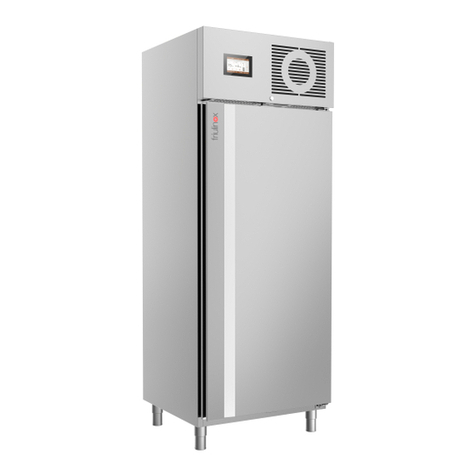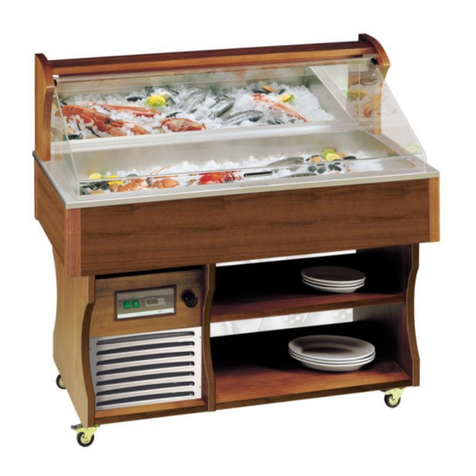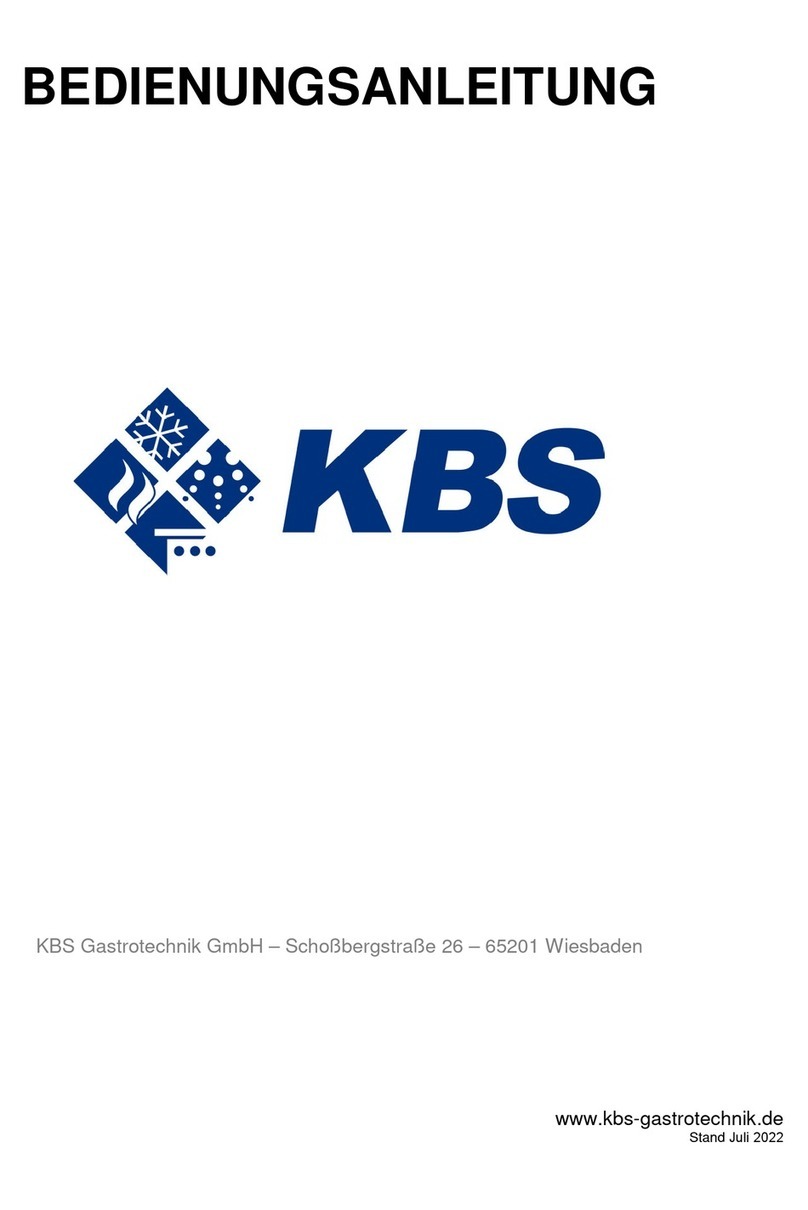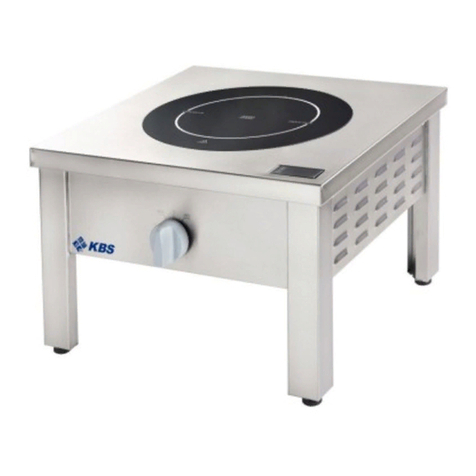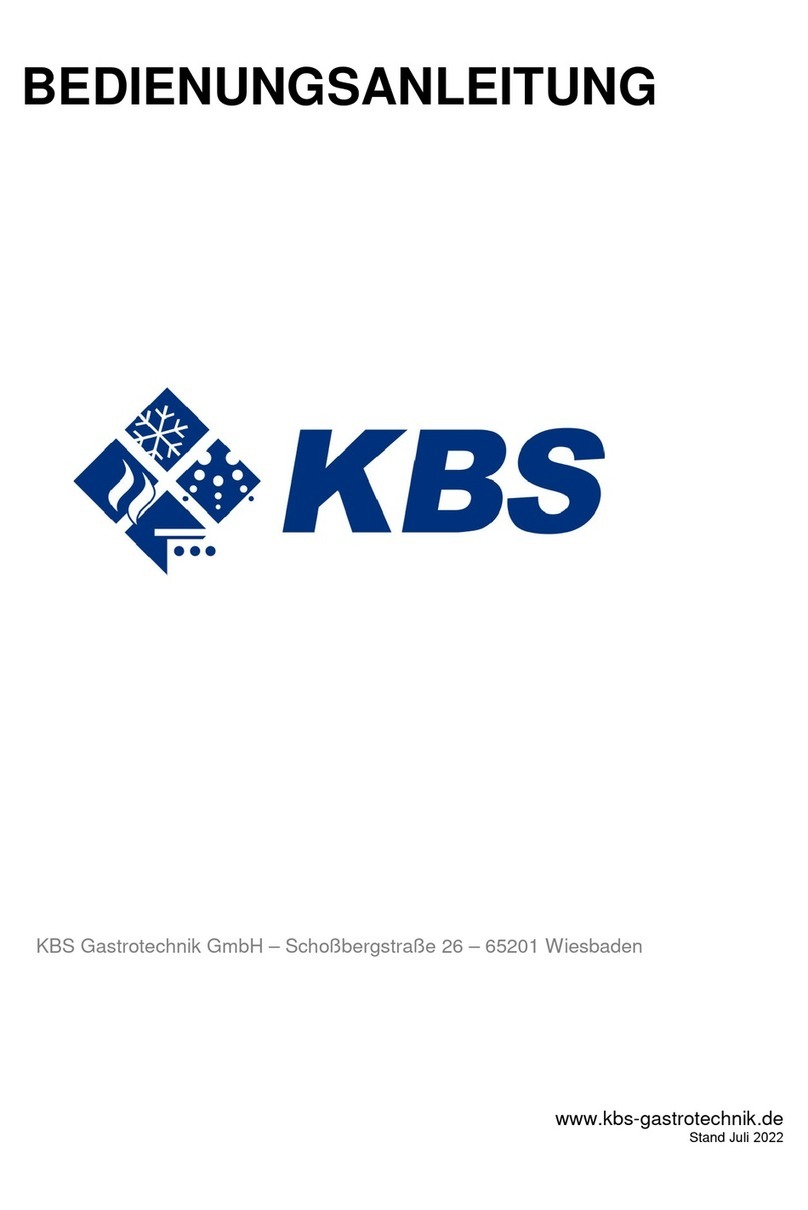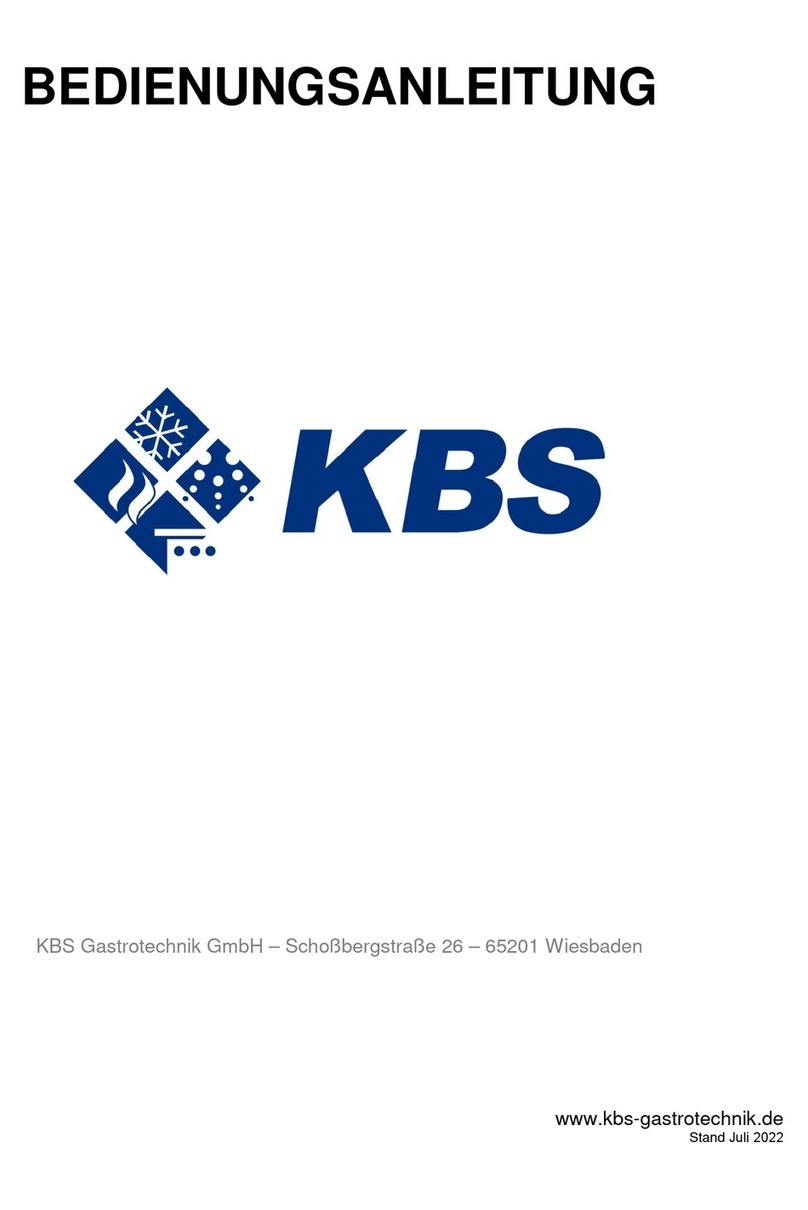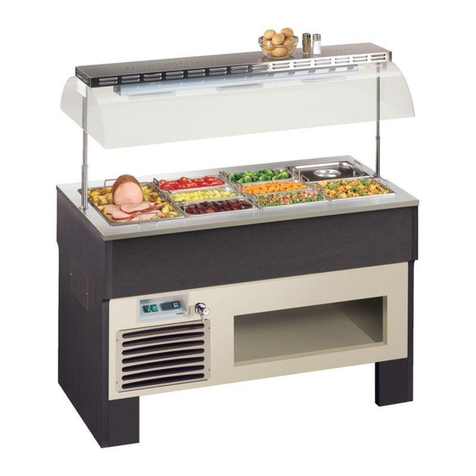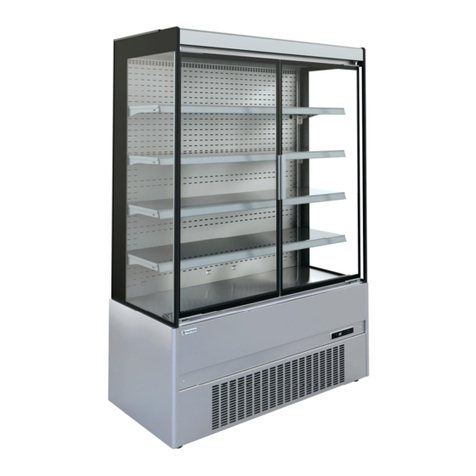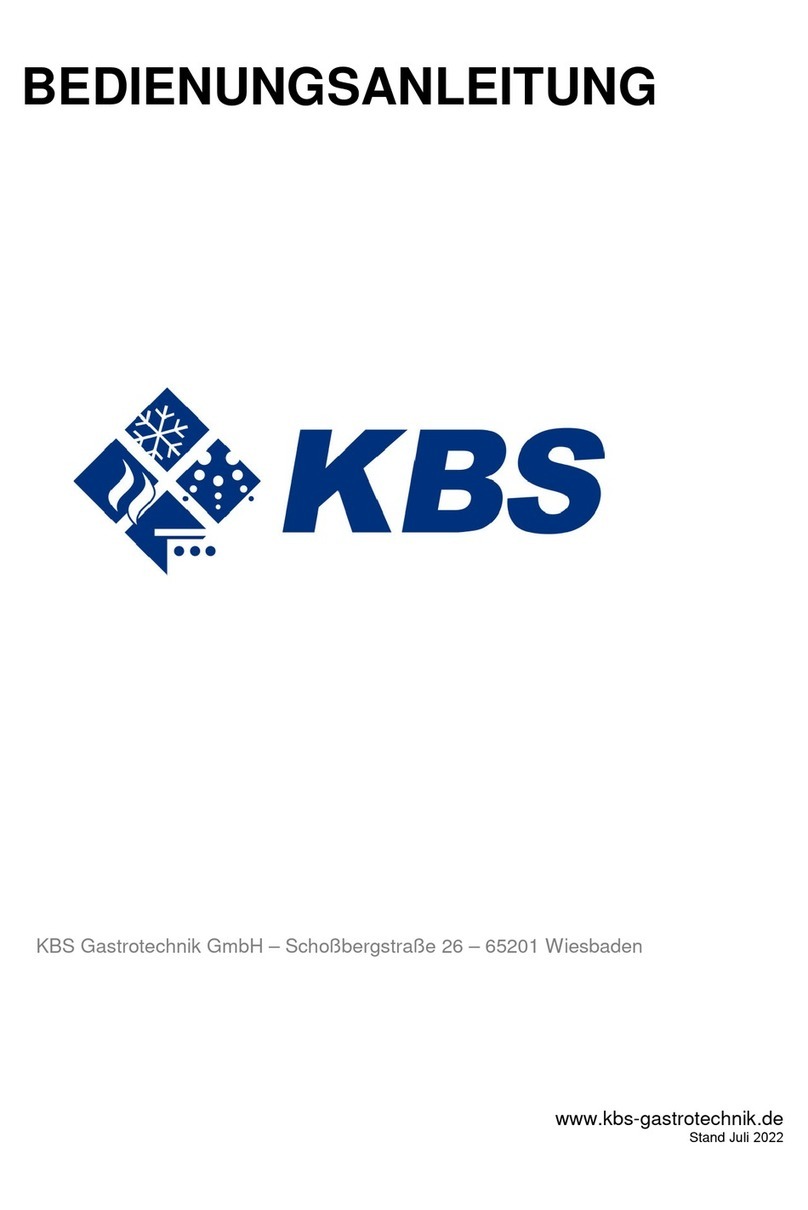
Übersetzung der Originalbetriebsanleitung DEUTSCH 9
9
Inbetriebnahme
WICHTIG
BEVOR MAN DAS GERÄT ANSCHLIESST, SOLLTE MAN SICH VERGEWISSERN, DASS DIE DATEN
DES LEISTUNGSSCHILDES DENEN DES STROMNETZES ENTSPRECHEN.
DAS GERÄTESCHILD, AUF DEM DIE FÜR DIE INSTALLATION ERFORDERLICHEN ELEKTRISCHEN
DATEN ANGEGEBEN SIND, BEFINDET SICH AUF DER RECHTEN SEITENWAND DES RAUMES.
Eine unkorrekte elektrische Versorgung könnte zu Brand, Stromschlag oder Unfällen führen.
DIE INSTALLATION MUSS GEMÄSS DEN ANGABEN DES ENTSPRECHENDEN ABSCHNITTS VON
QUALIFIZIERTEM FACHPERSONAL DURCHGEFÜHRT WERDEN.
DIE ELEKTRISCHE SICHERHEIT DIESES GERÄTES IST NUR DANN GARANTIERT, WENN DAS GERÄT
GEMÄSS DEN GELTENDEN ELEKTRISCHEN SICHERHEITSNORMEN AN EINE LESITUNGSFÄHIGE
ERDUNGSANLAGE ANGESCHLOSSEN IST.
Eine defekte Erdung kann im Fall von Fehlbetrieb einen Kurzschluss oder Stromschlag verursachen
DAS GERÄT MUSS AUSSERDEM IN EIN ÄQUIPOTENTIALSYSTEM EINGESCHLOSSEN WERDEN,
DESSEN LEISTUNGSFÄHIGKEIT GEMÄSS DEN GELTENDEN NORMEN GEPRÜFT WERDEN MUSS.
AUF KEINEN FALL ADAPTER, MEHRFACHSTECKDOSEN UND/ODER VERLÄNGERUNGSKABEL BENUTZEN.
EINLEITENDE ALLGEMEINE
KONTROLLEN
Sich überzeugen, dass sich die Auflagefläche für das
Gerätegewicht eignet und eben ist;
Das Gerät nivellieren. Gegebenenfalls den beweglichen Teil der
einstellbaren Füße einstellen, um eine perfekte Ausrichtung zu
erzielen. Eventuell eine entsprechende Wasserwaage verwenden.
Alle Füße müssen auf dem Boden aufliegen. Auf diese Weise
wird der korrekte Betrieb der Türen gesichert. Die
empfohlene Höchstabweichung von der horizontalen Ebene
beträgt +/- 0,5 Grad.
Gefährdet die Stabiliät des Gerätes welches demzufolge kippen kann.
Die korrekte Türfunktion könnte damit beeinträchtigt werden.
Sich für eine ausreichende Luftzirkulation sorgen und um
jeden Schaden am Kühlkreislauf zu vermeiden sich davon
überzeugen, dass das Gerät mit einem seitlichen Freiraum
von mindestens 50 mm und von mindestens 500 mm nach
oben aufgestellt wird; das Gerät nicht in der Nähe von
Wärmequellen (wie Öfen, Heizkörpern, etc ...) oder direktem
Sonnenlicht ausgesetzt, aufstellen und das Gerät.
Das Nichtbeachten dieser Normen, kann zu ernsten Schäden am
Kühlkreislauf sowie an den im Gerät gelagerten Produkten führen.
Falls das Gerät versetzt wurde, ist es erforderlich, bevor
dasselbe wieder eingeschaltet wird, eine bestimmte Zeit zu
warten. Vor allem falls die Handhabung nicht in senkrechter
Lage erfolgte, muss man mindestens 2 Stunden warten.
Die Schutzfolie von den Außenflächen abziehen und Innere mit
lauwarmem Wasser und neutralen Seife reinigen.
Die Schlüssel (falls vorhanden) müssen außerhalb der
Reichweite von Kindern aufbewahrt werden.
KONTROLLEN ELEKTRISCHEN TEILS
Die Werte der Netzspannung und –frequenz müsen mit denen
übereinstimmen, die auf dem Typenschild des Geräts
angegeben sind (Punkt 6 des Abschnitts "Matrikelangaben").
Eine unkorrekte Stromversorgung könnte einen Brand, Stromschlag
oder einen Unfall verursachen.
Der Steckdose eine Sicherung zu 16A vorschalten.
Den Hauptschalter, an den der Stecker des Netzkabels
angeschlossen wird, in die Position OFF bringen.
DIESES GERÄT MUSS MIT DEM MITGELIEFERTEN
STECKER AN DAS STROMNETZ ANGESCHLOSSEN WERDEN.
SOBALD DAS GERÄT INSTALLIERT WURDE, MUSS DER
STECKER LEICHT ZUGÄNGLICH SEIN.
Sicherstellen, dass die Steckdose mit dem Netzstecker des
Geräts kompatibel ist. WendenSie sich an Fachpersonal, falls die
Netzsteckdose durch eine eines anderen Typs ausgewechselt
werden muss. Dieses Fachpersonal muss sicherstellen, dass der
Querschnitt der Leiter der Netzsteckdose der Leistungsaufnahme
des Geräts angemessen ist.
Nachdem die obengenannten Anweisungen sorgfältig
durchgeführt wurden, kann das Gerät in Betrieb gesetzt werden:
Den Hauptschalter, an dem der Stecker des Versorgungskabels
angeschlossen ist, in Position ON bringen.
Den Schalter des Gerätes in die Position ON bringen.
Nach 1 Minute startet der Kompressor und die Innentemperatur
wird auf den werkseitig eingestellten Sollwert gebracht.
Das Gerät nicht beladen, solange die Temperatur den
voreingestellten Sollwert nicht erreicht hat.
Sollte es notwendig sein, die werkseitig eingestellten Parameter
zu ändern, sind die im Kapitel "Schalttafel" aufgeführten
Anleitungen zu lesen.
BEVOR MAN DIE LEBENSMITTEL EINFÜHRT, DAS GERÄT IN
BETRIEBSZUSTAND BRINGEN.
DIE IM RAUMINNERENANGEZEIGTE LADELINIE NIE ÜBERSCHREITEN.
BETRIEB
Die richtige Konservierung der Lebensmittel stellt einen wichtigen
Aspekt bezüglich der hygienischen und sicheren
Lebensmittelproduktion dar, verbessert die Effizienz der
gastronomischen Tätigkeiten und wirkt sich positiv auf den
Stromverbrauch aus. Die unten aufgeführten Anweisungen
beachten, um die bestmögliche Leistung des Gerätes zu erzielen.
Die Produkte müssen stets auf den Ablagen gelagert werden;
keine Produkte auf den Kühlraumboden legen.
DIE LEBENSMITTEL MÜSSENSO IN DAS GERÄT GELEGT
WERDEN, DASS EIN FREIER LUFTSTROM GEWÄHRLEISTETIST.
ZWISCHEN DEN JEWEILIGEN LEBENSMITTELN AUSREICHENDPLATZ
LASSEN UNDSIE NICHT INBERÜHRUNG MIT DENSEITENWÄNDEN
BRINGEN. IM BEDARFSFALL DEN ABSTAND DER ABLAGEN ÄNDERN.
